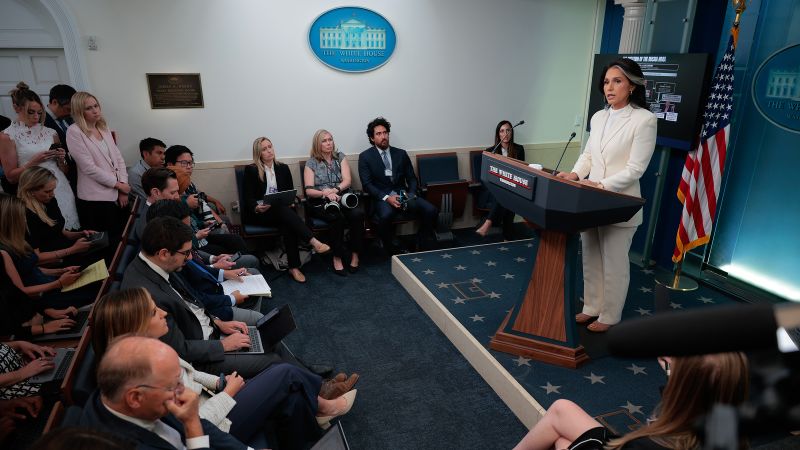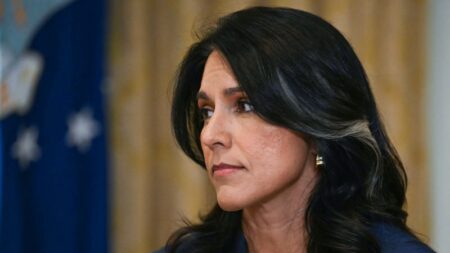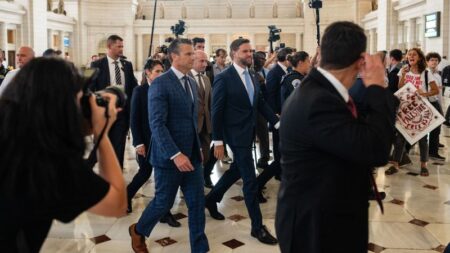In a dramatic unfolding of events, President Donald Trump recently accused Barack Obama, the former president, of treason concerning the intelligence report that indicated Russian interference in the 2016 election aimed at bolstering Trump’s candidacy. His claims were echoed by the Director of National Intelligence, Tulsi Gabbard, who declassified a report that she stated serves as further evidence of a so-called “treasonous conspiracy.” This action occurred right after Trump’s allegations, instigating a political wildfire amid accusations and counterclaims surrounding the contentious topic of election interference.
The release of this redacted report, which originated from the Republican majority of the House Intelligence Committee during the early years of the Trump administration, signifies another component of a broader initiative by Gabbard and other Trump associates aimed at challenging the validity of the FBI’s investigation into Russian involvement in the electoral process. The report has become a pivotal document in ongoing discussions over the legitimacy of election security and the specter of foreign interference.
Shortly thereafter, Pam Bondi, the Attorney General, made an announcement regarding the establishment of a unit by the Justice Department. This unit is tasked with examining the evidence presented by Gabbard and determining any potential legal actions that might arise from her disclosures. This development underscores the grave seriousness with which these accusations are taken within the halls of power—an indication that legal ramifications might still unfold in the wake of these reports.
During a press briefing at the White House, Gabbard refrained from directly accusing Obama of treason but insinuated that the data released pointed towards Obama orchestrating the creation of the intelligence assessment that alleged Russian interference. She claimed that the conclusion, which suggested that Russia aimed to influence the election outcome in favor of Trump, was a fabricated narrative pushed to deceive the public. In her view, the objective was not to assist Trump, but to foster disbelief in the American democratic system.
However, Gabbard’s allegations that the intelligence reports were manufactured lack robust support from the newly declassified House report, or from CIA Director John Ratcliffe’s assessments that have come to light in recent weeks. Ratcliffe’s report questioned the strength of the claims regarding Russia’s desire to assist Trump, stating that the assessment indicating such was not warranted as a high-confidence conclusion. Nonetheless, it affirmed that the general assessment had substantive support.
The House report, which included operations so sensitive that it was secured within a “turducken”—a safe within a safe at the CIA headquarters—found that while the intelligence gathering had some weaknesses, it did not endorse Gabbard’s notion that the findings were fabricated. This varied perspective highlights the convoluted nature of the evidence regarding the claims of Russian meddling in the election.
In the realm of intelligence accountability and transparency, Gabbard’s choice to release this document generated considerable backlash from Democrats. They charged that her actions compromised the integrity of intelligence sources and methods. Senator Mark Warner, a leading Democrat on the Senate Intelligence Committee, issued a statement of condemnation, accusing Gabbard of imperiling vital information that serves to protect national interests. The fallout of her actions raised questions concerning the safeguarding of intelligence partnerships and operational security.
Furthermore, the rush to declassify and publicize this report sparked concerns from within the intelligence community. Reports surfaced about the incomplete process of redaction prior to Gabbard’s announcement. A former U.S. intelligence official voiced alarm about the potential ramifications of the materials released. There were significant fears that exposing portions of the report could jeopardize operatives and their sources, revealing methods that the U.S. employs to monitor Russian activities.
The intelligence discussions surrounding the 2016 election remain fraught with controversy. The narrative of Russian interference has led to notable investigations and inquiries, including the many facets of the House report itself. The handling of sensitive intelligence data has become a cautionary tale of the tensions between political agendas and national security—a theme likely to echo in U.S. political discourse for years to come.
As discussions evolve, the broader implications concerning the relationship between American adversaries and the integrity of the intelligence community continue to provoke debate over how sensitive national security information should be handled in the public sphere. The phenomenon of selective declassification results in the interplay of partisan motivations and national interests, illustrating the complex dynamics of trust and truth in contemporary governance.











